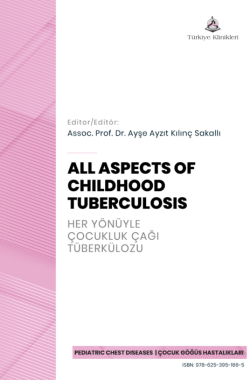Pathogenesis of Tuberculosis Disease
Raziye ATANa , Emine Nural KİPERa
aHacettepe University Faculty of Medicine, Department of Pediatric Chest Diseases, Ankara, Türkiye
Atan R, Kiper EN. Pathogenesis of tuberculosis disease. In: Kılınç Sakallı AA, ed. All Aspects of Childhood Tuberculosis. 1st ed. Ankara: Türkiye Klinikleri; 2023. p.7-9.
ABSTRACT
Tuberculosis is caused by Mycobacterium tuberculosis and it is one of the greatest infectious causes of death in people globally. It is largely a pathogen of the respiratory tract. However, particular infections arise at extrapulmonary locations, posing significant challenges in illness diagnosis and treatment. There are also disseminated infections, which occur as a result of reseeding from the lungs through the lymphatic and vascular systems. The clinical outcome of tuberculosis is influenced by the host immune response, environmental factors, and pathogen characteristics. It has long been recognized that tuberculosis induces both protective and tissue damaging immune responses. The clinical outcome depends on the balance between all these factors. Also understanding the immunopathogenesis is crucial for monitoring treatment and developing new treatments.
Keywords: Tuberculosis; pathogenesis; physiopathology; child; pediatrics
Kaynak Göster
Referanslar
- Moule MG, Cirillo JD. Mycobacterium tuberculosis dissemination plays a critical role in pathogenesis. Front cell infect microbiol. 2020;10:65. [Crossref] [PubMed] [PMC]
- Hunter RL. The pathogenesis of tuberculosis: the early infiltrate of post-primary (adult pulmonary) tuberculosis: a distinct disease entity. Front Immunol. 2018;9:2108. [Crossref] [PubMed] [PMC]
- Wilson JL, Mayr HK, Weichhart T. Metabolic programming of macrophages: implications in the pathogenesis of granulomatous disease. Front Immunol. 2019;10:2265. [Crossref] [PubMed] [PMC]
- Gaffney E, Murphy D, Walsh A, Connolly S, Basdeo S, Keane J, et al. Defining the role of neutrophils in the lung during infection: Implications for tuberculosis disease. Front Immunol. 2022;13:984293. [Crossref] [PubMed] [PMC]
- McHenry ML, Williams SM, Stein CM. Genetics and evolution of tuberculosis pathogenesis: New perspectives and approaches. Infect Genet Evol. 2020;81:104204. [Crossref] [PubMed] [PMC]
- Horsburgh Jr CR, Rubin EJ. Latent tuberculosis infection in the United States. N Engl J Med. 2011;364(15):1441-8. [Crossref] [PubMed]
- Smith GS, Van Den Eeden SK, Baxter R, Shan J, Van Rie A, Herring AH, et al. Cigarette smoking and pulmonary tuberculosis in northern California. J Epidemiol Community Health. 2015;69(6):568-73. [Crossref] [PubMed]
- Lahey T, MacKenzie T, Arbeit RD, Bakari M, Mtei L, Matee M, et al. Recurrent tuberculosis risk among HIV-infected adults in Tanzania with prior active tuberculosis. Clin Infect Dis. 2013;56(1):151-8. [Crossref] [PubMed] [PMC]
- Orgeur M, Brosch R. Evolution of virulence in the Mycobacterium tuberculosis complex. Curr Opin Microbiol. 2018;41:68-75. [Crossref] [PubMed]
- Queiroz A, Riley LW. Bacterial immunostat: Mycobacterium tuberculosis lipids and their role in the host immune response. Rev Soc Bras Med Trop. 2017;50:09-18. [Crossref] [PubMed]
- Uchida Y, Casali N, White A, Morici L, Kendall LV, Riley LW. Accelerated immunopathological response of mice infected with Mycobacterium tuberculosis disrupted in the mce1 operon negative transcriptional regulator. Cell Microbiol. 2007;9(5):1275-83. [Crossref] [PubMed]
- Heldwein KA, Fenton MJ. The role of Toll-like receptors in immunity against mycobacterial infection. Microbes Infect. 2002;4(9):937-44. [Crossref] [PubMed]
- Philips JA, Ernst JD. Tuberculosis pathogenesis and immunity. Annu Rev Pathol. 2012;7:353-84. [Crossref] [PubMed]
- Pan H, Dai Y, Tang S, Wang J. Polymorphisms of NOD2 and the risk of tuberculosis: a validation study in the Chinese population. Int J Immunogenet. 2012;39(3):233-40. [Crossref] [PubMed]
- Chin KL, Anis FZ, Sarmiento ME, Norazmi MN, Acosta A. Role of interferons in the development of diagnostics, vaccines, and therapy for tuberculosis. J Immunol Res. 2017;2017. [Crossref] [PubMed] [PMC]
- Click ES, Moonan PK, Winston CA, Cowan LS, Oeltmann JE. Relationship between Mycobacterium tuberculosis phylogenetic lineage and clinical site of tuberculosis. Clin Infect Dis. 2012;54(2):211-9. [Crossref] [PubMed]
- Huyen MN, Buu TN, Tiemersma E, Lan NT, Dung NH, Kremer K, et al. Tuberculosis relapse in Vietnam is significantly associated with Mycobacterium tuberculosis Beijing genotype infections. J Infect Dis. 2013;207(10):1516-24. [Crossref] [PubMed]
- Kampmann B, Hemingway C, Stephens A, Davidson R, Goodsall A, Anderson S, et al. Acquired predisposition to mycobacterial disease due to autoantibodies to IFN-γ. J Clin Investig. 2005;115(9):2480-8. [Crossref] [PubMed] [PMC]

